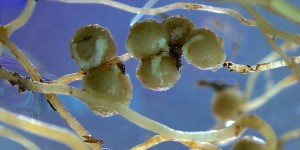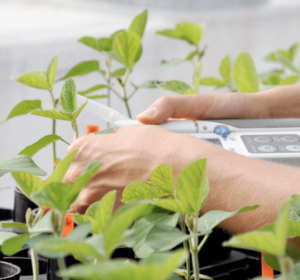The activities are as follows:
- Teacher Guide
- Student activity, Graph Type A, Level 3
- Student activity, Graph Type B, Level 3
- Student activity, Graph Type C, Level 3
- Grading Rubric
When two species do better when they cooperate than they would on their own, the relationship is called a mutualism. One example of a mutualism is the relationship between a type of bacteria, rhizobia, and legume plants. Legumes include plants like peas, beans, soybeans, and clover. Rhizobia live in bumps on the legume roots, where they trade their nitrogen for sugar from the plants. Rhizobia fix nitrogen from the air into a form that plants can use. This means that legumes that have rhizobia living in their roots can get more nitrogen than those that don’t.
Under some conditions, this mutualism can break down. For example, if one of the traded resources is very abundant in the environment. When the plant doesn’t need the nitrogen traded by rhizobia, it doesn’t trade as many sugars to the rhizobia. This could cause the rhizobia to evolve to be less cooperative as well. Less-cooperative rhizobia may be found where the soil already has lots of nitrogen. These less-cooperative bacteria are freeloaders: they fix less nitrogen, but still get sugars from the plant and other benefits of living in nodules on their roots.

Rhizobia nodules on plant roots. In exchange for carbon and protection in the nodules from plants, rhizobia provide fixed nitrogen for plants.
One very important legume crop species is the soybean. Soybeans are used to produce vegetable oil, tofu, soymilk, and many other food products. Soybeans trade with rhizobia for nitrogen, but often farmers add more nitrogen into the field as fertilizer. Since farms use a lot of nitrogen fertilizer, researchers at KBS were interested in how different types of farming affected the plant-rhizobia mutualism.
They grew soybean plants in a greenhouse and added rhizobia from three different farms: a high N farm, low N farm, and organic farm that used no N fertilizer. After four weeks, the researchers measured chlorophyll content of the soybean plants. Healthy plants that have lots of nitrogen will have high chlorophyll content, and plants with not enough nitrogen will have low chlorophyll content. Because high nitrogen could lead to the evolution of less-cooperative rhizobia, they expected that rhizobia from organic plots would be most cooperative. They predicted rhizobia from high N plots would be the least cooperative, and rhizobia from low N plots would fall somewhere in the middle. More-cooperative rhizobia provide more nitrogen, so the researchers expected plants grown with cooperative rhizobia to have higher chlorophyll content than plants receiving less-cooperative rhizobia.
Featured scientist: REU Jennifer Schmidt from the Kellogg Biological Station
Flesch–Kincaid Reading Grade Level = 10.1
For more information on the evolution of cheating rhizobia, check out these popular science articles:
If you are interested in performing your own classroom experiment using the plant-rhizobium mutualism, check out this paper published in the American Biology Teacher describing methods and a proposed experimental design: Suwa and Williamson 2014


I might be missing something, but I think this exercise is flawed. The data provided in this exercise doesn’t address the scientific question. The data tells us the relationship between available N and chlorophyll production, but it doesn’t tell us anything about the role of rhizobia. To answer that question one would need information on Nitrogen fixation rates between rhizobial species isolated from each of the field types.
There is a Teacher Guide available for each Data Nugget. To obtain this, please fill out the form here (http://datanuggets.org/requesting-teacher-guides/). However, we only share the guides with teachers so if you are a student you will be unable to access the answer key.